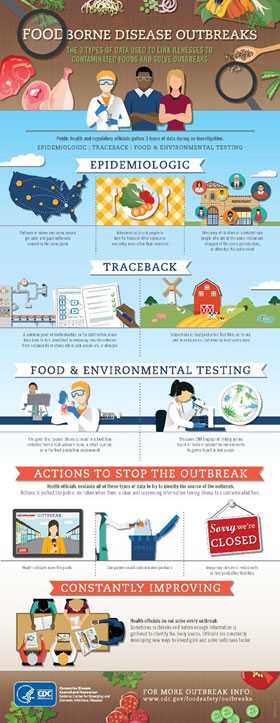Investigating Outbreaks
Using Data to Link Foodborne Disease Outbreaks to a Contaminated Source
When a foodborne disease outbreak is detected, public health and regulatory officials work quickly to collect as much information as possible to find out what is causing it, so they can take action to prevent more people from getting sick. During an investigation, health officials collect three types of data: epidemiologic, traceback, and food and environmental testing.
Health officials assess all of these types of data together to try to find the likely source of the outbreak. They take action, such as warning the public, when there is clear and convincing information linking illness to a contaminated food.
Epidemiologic Data:
- Patterns in the geographic distribution of illnesses, the time periods when people got sick, and past outbreaks involving the same germ.
- Foods or other exposures occurring more often in sick people than expected
- Clusters of unrelated sick people who ate at the same restaurant, shopped at the same grocery store, or attended the same event.
Traceback Data:
- A common point of contamination in the distribution chain, identified by reviewing records collected from restaurants and stores where sick people ate or shopped.
- Findings of environmental assessments in food production facilities, farms, and restaurants identifying food safety risks.
Food and Environmental Testing Data:
- The germ that caused illness found in a food item collected from a sick person’s home, a retail location, or in the food production environment
- The same DNA fingerprint linking germs found in foods or production environments to germs found in sick people
Health officials don’t solve every outbreak. Sometimes outbreaks end before enough information is gathered to identify the likely source. Officials thoroughly investigate each outbreak, and they are constantly developing new ways to investigate and solve outbreaks faster.
- Page last reviewed: May 25, 2016
- Page last updated: September 5, 2017
- Content source:


 ShareCompartir
ShareCompartir
